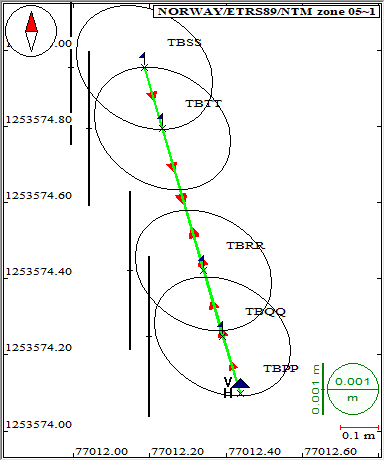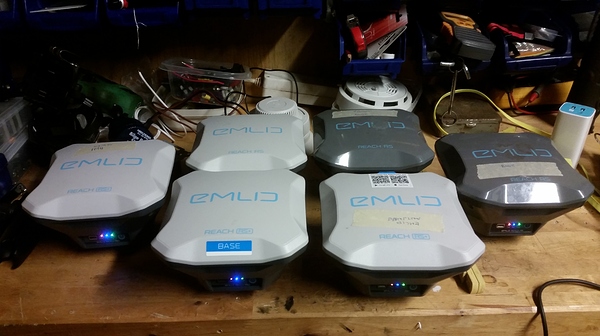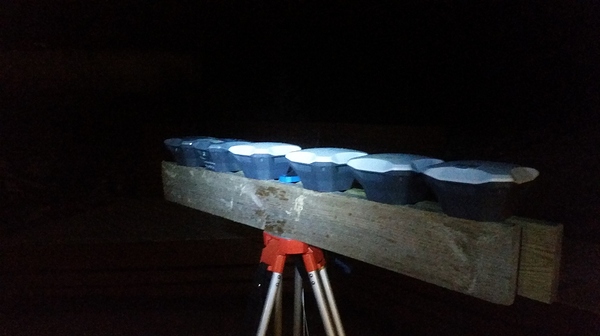No problem, I value your contributions, I didn’t think you hijack the thread but you have a more structured view of the topic which is very helpful.
I think in order to solve the problem with finding the phase center we need to list the sources of error.
I have 3 Reach units and soon 1 Reach + unit. I guess a test setup would look like that:
- mount all units on a perfectly leveled square mounted above a known point and measure the position for 24 h. Turn the square 180 degrees and measure again for 24 h.
- if we get a deviation in the measure z value interchange the receivers and repeat the measurement, hopefully we get the same results.
- if we substract the pole length we should get a value which is the sum of several errors, the phase center offset and other things influencening the measurement accuracy. If we could quantify each of the errors or apply some fancy statistics over a lot of measurements we could get the phase center offset value.
Can someone make a list of these things? I start with a random list:
- phase center offset
- not perfectly vertical mount
- mount length change due to temperature differences
- multipath errors
- signal quality deteroiation due to clouds, sun bursts,…
- number of satellites
- baseline
- electric noise
- …
Before we do all of this, I think it worth asking Emlid…
@dmitriy.ershov & @egor.fedorov, any input on this, before we spent a massive amount of time?
Just for the shear fun of it, i would like to just put a bunch of RS up and see what values it produce :smiley
Also welcome any input on that matter
The experiments suggested here sound really fun!  Antennas in Reach RS/RS+ have phase center variation within a few mm, I doubt that it makes a lot of sense to try and calibrate that out. Other factors listed here are likely to have a much more noticeable effect.
Antennas in Reach RS/RS+ have phase center variation within a few mm, I doubt that it makes a lot of sense to try and calibrate that out. Other factors listed here are likely to have a much more noticeable effect.
Good evening fellows.
Here is my contribution for the Z error mission. Sorry to say but there is nothing exciting to report from my leveled station. Few millimeter but nothing more, pictures talk for them selfs.
About my setup:
6 units ranging from prereleases Reach RS models to latest state of the art. The letters on the picture should be enough for those interested 
What is did was placing all six on a leveled stand (leveled to within 1-2mm), all unites configed with the same setting, recorded raw.ubx and all processed with the same setting.
I used RS1 as base for RS2, RS3, RS+, RS+BASE and RS+IMU and then used RS1 as rover against RS2 as base for good measure. All units measured relative to the other.
The one deviate from the rest is RS3. That one has suffered from a fall, that might be the cause of the 5mm higher Z values. But still way within the spec.
Cudos to Emlid for their stable phase on RS 
Nice, thank very much. Could someone repeat that for the original Reach?
Based on the TBK_RTK checking, the evaluation of PCV (Phase Center Variation) is 3mm (1 sigma). If we take into account the leveling errors, you can actually talk about PCV accuracy +/- 2mm.
!

This is a thread of a funny approach to a more professional one.![]()
It would be better to read before "Antenna Calibrations’
Thanks @r.pazus.
But since you blew the lights out on my birthday cake (Figure of speech), can you please tell me how you fixed TBVV? 

Excuse me. I’m sure your birthday cake will shine again when you start similar tests with Tallysman multi-GNSS antennas. I’ll try not to disturb you.  Despite the fact that I am opposed to the aluminum foil.
Despite the fact that I am opposed to the aluminum foil.
TBVV added to the project by trimming few milliseconds of it which made it a stop&go session and able to process it for some odd reason.
2mm . Not bad at all
Meters, but as in 2mm.
My bad 
Could have been nice though 
This topic was automatically closed 100 days after the last reply. New replies are no longer allowed.








